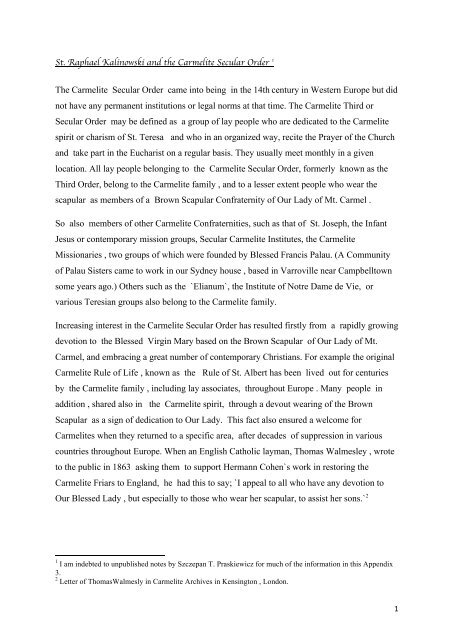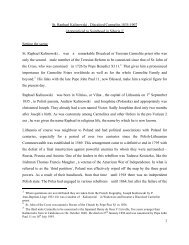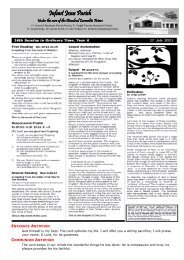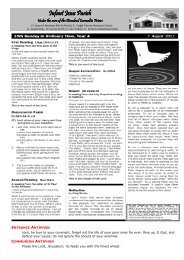St. Raphael Kalinowski and the Carmelite Secular Order 1 The ...
St. Raphael Kalinowski and the Carmelite Secular Order 1 The ...
St. Raphael Kalinowski and the Carmelite Secular Order 1 The ...
Create successful ePaper yourself
Turn your PDF publications into a flip-book with our unique Google optimized e-Paper software.
<strong>St</strong>. <strong>Raphael</strong> <strong>Kalinowski</strong> <strong>and</strong> <strong>the</strong> <strong>Carmelite</strong> <strong>Secular</strong> <strong>Order</strong> 1<br />
<strong>The</strong> <strong>Carmelite</strong> <strong>Secular</strong> <strong>Order</strong> came into being in <strong>the</strong> 14th century in Western Europe but did<br />
not have any permanent institutions or legal norms at that time. <strong>The</strong> <strong>Carmelite</strong> Third or<br />
<strong>Secular</strong> <strong>Order</strong> may be defined as a group of lay people who are dedicated to <strong>the</strong> <strong>Carmelite</strong><br />
spirit or charism of <strong>St</strong>. Teresa <strong>and</strong> who in an organized way, recite <strong>the</strong> Prayer of <strong>the</strong> Church<br />
<strong>and</strong> take part in <strong>the</strong> Eucharist on a regular basis. <strong>The</strong>y usually meet monthly in a given<br />
location. All lay people belonging to <strong>the</strong> <strong>Carmelite</strong> <strong>Secular</strong> <strong>Order</strong>, formerly known as <strong>the</strong><br />
Third <strong>Order</strong>, belong to <strong>the</strong> <strong>Carmelite</strong> family , <strong>and</strong> to a lesser extent people who wear <strong>the</strong><br />
scapular as members of a Brown Scapular Confraternity of Our Lady of Mt. Carmel .<br />
So also members of o<strong>the</strong>r <strong>Carmelite</strong> Confraternities, such as that of <strong>St</strong>. Joseph, <strong>the</strong> Infant<br />
Jesus or contemporary mission groups, <strong>Secular</strong> <strong>Carmelite</strong> Institutes, <strong>the</strong> <strong>Carmelite</strong><br />
Missionaries , two groups of which were founded by Blessed Francis Palau. (A Community<br />
of Palau Sisters came to work in our Sydney house , based in Varroville near Campbelltown<br />
some years ago.) O<strong>the</strong>rs such as <strong>the</strong> `Elianum`, <strong>the</strong> Institute of Notre Dame de Vie, or<br />
various Teresian groups also belong to <strong>the</strong> <strong>Carmelite</strong> family.<br />
Increasing interest in <strong>the</strong> <strong>Carmelite</strong> <strong>Secular</strong> <strong>Order</strong> has resulted firstly from a rapidly growing<br />
devotion to <strong>the</strong> Blessed Virgin Mary based on <strong>the</strong> Brown Scapular of Our Lady of Mt.<br />
Carmel, <strong>and</strong> embracing a great number of contemporary Christians. For example <strong>the</strong> original<br />
<strong>Carmelite</strong> Rule of Life , known as <strong>the</strong> Rule of <strong>St</strong>. Albert has been lived out for centuries<br />
by <strong>the</strong> <strong>Carmelite</strong> family , including lay associates, throughout Europe . Many people in<br />
addition , shared also in <strong>the</strong> <strong>Carmelite</strong> spirit, through a devout wearing of <strong>the</strong> Brown<br />
Scapular as a sign of dedication to Our Lady. This fact also ensured a welcome for<br />
<strong>Carmelite</strong>s when <strong>the</strong>y returned to a specific area, after decades of suppression in various<br />
countries throughout Europe. When an English Catholic layman, Thomas Walmesley , wrote<br />
to <strong>the</strong> public in 1863 asking <strong>the</strong>m to support Hermann Cohen`s work in restoring <strong>the</strong><br />
<strong>Carmelite</strong> Friars to Engl<strong>and</strong>, he had this to say; `I appeal to all who have any devotion to<br />
Our Blessed Lady , but especially to those who wear her scapular, to assist her sons.`2<br />
1 I am indebted to unpublished notes by Szczepan T. Praskiewicz for much of <strong>the</strong> information in this Appendix<br />
3.<br />
2 Letter of ThomasWalmesly in <strong>Carmelite</strong> Archives in Kensington , London.<br />
<br />
1
It is true of course also that <strong>the</strong> <strong>Carmelite</strong> <strong>Order</strong> would have been known through <strong>the</strong><br />
presence of <strong>the</strong> sisters in Engl<strong>and</strong> in <strong>the</strong> preceding centuries , but inevitably <strong>the</strong>ir hidden<br />
contemplative life would have placed limits on how well <strong>the</strong> <strong>Order</strong> was known.<br />
Secondly, interest springs from a former religious culture itself <strong>and</strong> <strong>the</strong> desire people<br />
traditionally have had to identify with <strong>the</strong> spirit or charism of a particular <strong>Order</strong>: to that<br />
extent <strong>the</strong> faithful wished to be closely connected with religious <strong>Order</strong>s which were - in <strong>the</strong>ir<br />
opinion - <strong>the</strong> most certain way to salvation. People often wished to wear a symbol of <strong>the</strong><br />
particular <strong>Order</strong> such as a medal or scapular, <strong>and</strong> to follow <strong>the</strong> <strong>Order</strong>s' spiritual practices,<br />
as well as to be buried in <strong>the</strong> habit of <strong>the</strong> <strong>Order</strong> . <strong>The</strong> latter was quite common in countries<br />
like Irel<strong>and</strong> up to <strong>the</strong> recent past.<br />
<strong>The</strong>re was a widespread revival of this wish to find support <strong>and</strong> guidance for a life of prayer<br />
on <strong>the</strong> part of many people towards <strong>the</strong> end of <strong>the</strong> nineteenth century. This development led<br />
to a growth in <strong>the</strong> <strong>Carmelite</strong> <strong>Secular</strong> <strong>Order</strong>.<br />
<strong>St</strong>. <strong>Raphael</strong> <strong>Kalinowski</strong>, was a restorer of <strong>Carmelite</strong> life in Pol<strong>and</strong> for Friars <strong>and</strong> nuns as we<br />
saw. He was also instrumental in renewing <strong>the</strong> Third or <strong>Secular</strong> <strong>Order</strong> of Carmel.He was<br />
sensitive to <strong>the</strong> needs of <strong>the</strong> faithful <strong>and</strong> he devoted himself fully to <strong>the</strong>m , spending a lot of<br />
time celebrating <strong>the</strong> Sacrament of Penance <strong>and</strong> opening to <strong>the</strong>m <strong>the</strong> treasures of <strong>Carmelite</strong><br />
spirituality . He could be said to have brought <strong>Carmelite</strong> spirituality closer to lay people in<br />
many different ways - publishing various leaflets, books, giving talks, promoting <strong>the</strong> Brown<br />
Scapular, writing letters to people in a number of surrounding countries, such as Russia,<br />
Hungary <strong>and</strong> Romania.<br />
<strong>The</strong> <strong>Secular</strong> <strong>Carmelite</strong> <strong>Order</strong> <strong>and</strong> <strong>the</strong> Confraternity of <strong>the</strong> Brown Scapular.<br />
In 1902 <strong>Kalinowski</strong> established, a scapular Confraternity in Sulina, Romania, through his<br />
friend Teresa Moruzi, a member of <strong>the</strong> <strong>Secular</strong> <strong>Order</strong> , <strong>and</strong> he tried to obtain for it<br />
canonical recognition from <strong>the</strong> General of <strong>the</strong> <strong>Order</strong> by sending him <strong>the</strong> necessary<br />
application forms . He encouraged Jesuits working in a place called Jassy 3 to propagate<br />
devotion to <strong>the</strong> Scapular <strong>and</strong> also wrote to <strong>the</strong> Austrian Consul`s daughter Fanny Jelinek<br />
4 in Sulina asking her to spread <strong>the</strong> scapular devotion.<br />
3 <strong>The</strong> second most populous city in Romania, also known as Lassey <strong>and</strong> Lasi.It is an important cultural center.<br />
4 Her fa<strong>the</strong>r Franz Jelinek was Consul in Sulina at this time. I t not clear how <strong>Kalinowski</strong> knew <strong>the</strong>m, perhaps<br />
through <strong>the</strong> Moruzi family.<br />
<br />
2
Catholic priests in Romania reported what a positive influence <strong>the</strong> scapular was in Christian<br />
life. <strong>The</strong>re were instances of conversions from Orthodox Christianity to Catholicism due to<br />
<strong>the</strong> scapular. <strong>Raphael</strong> even made plans to establish <strong>the</strong> <strong>Secular</strong> <strong>Order</strong> of Carmel in<br />
connection with a <strong>Carmelite</strong> house in <strong>the</strong> capital Bucharest.<br />
He also eagerly propagated devotion to <strong>the</strong> scapular in Pol<strong>and</strong> itself <strong>and</strong> tried to encourage<br />
priests in <strong>the</strong> surrounding territories to join <strong>the</strong> scapular Confraternity. He wrote to a certain<br />
Irena Balatowska : `Do try hard to establish Holy Scapular Confraternity in your parish <strong>and</strong><br />
become a promoter of devotion to <strong>the</strong> Blessed Virgin.<br />
In his letters he insisted on how people should pray in relation to wearing <strong>the</strong> scapular, so<br />
that wearing it didn’t tend to become routine or border on <strong>the</strong> superstitious. He translated<br />
various spiritual books such as a guide for daily meditations on <strong>the</strong> Virgin Mary with <strong>the</strong><br />
intention of publishing <strong>the</strong>m.<br />
In his ministry in <strong>the</strong> various Churches he served , he transformed <strong>the</strong>m into sanctuaries of<br />
<strong>the</strong> Virgin Mary of <strong>the</strong> Scapular ; in Czerna itself which became a great pilgrimage center,<br />
<strong>and</strong> in that of <strong>St</strong>. Joseph in Wadowice , a house he himself had founded. During his stay in<br />
Czerna , group pilgrimages from <strong>the</strong> Prussian sector of Silesia came to seek spiritual<br />
direction from him. Here <strong>the</strong>y would buy Polish religious books available in <strong>the</strong> Priory.<br />
Though <strong>the</strong> <strong>Carmelite</strong> <strong>Secular</strong> <strong>Order</strong> <strong>and</strong> <strong>the</strong> Scapular Confraternity are distinct <strong>the</strong>y are<br />
interrelated. Part of <strong>the</strong> ceremonial for induction into <strong>the</strong> secular <strong>Order</strong> ( as indeed for <strong>the</strong><br />
o<strong>the</strong>r two <strong>Order</strong>s) is <strong>the</strong> conferring of <strong>the</strong> scapular. From <strong>the</strong> point of view of <strong>the</strong> Church`s<br />
formal worship a scapular, in connection with whatever <strong>Order</strong>, is called a sacramental, just<br />
like holy water or a religious medal. It is called a `sacramental` because though it is related to<br />
<strong>the</strong> church`s sacraments, it is not part of <strong>the</strong> seven.A sacramental can prepare <strong>and</strong> lead up to a<br />
fruitful participation in <strong>the</strong> life of <strong>the</strong> sacraments, <strong>and</strong> it can help people prolong this<br />
fruitfulness by having a blessed object on one`s person or in <strong>the</strong> home. <strong>The</strong> value of <strong>the</strong><br />
sacramental does nor reside in <strong>the</strong> object itself but in <strong>the</strong> rite for blessing <strong>the</strong> object carried<br />
out by an approved minister of <strong>the</strong> church. <strong>The</strong> rite for <strong>the</strong> blessing <strong>and</strong> enrolment in <strong>the</strong> a<br />
particular scapular devotion was approved by a Decree from <strong>the</strong> Congregation for Divine<br />
Worship on 27 January 1989 <strong>and</strong> signed by Cardinal Martinez. Formal membership of a<br />
Confraternity of <strong>the</strong> Brown Scapular is not required in order for a person to be enrolled. In<br />
<strong>the</strong> enrolment ceremony <strong>the</strong> cloth scapular is always used but subsequently a medal can be<br />
substituted for this , especially in warmer countries <strong>and</strong> according to individual preferences.<br />
<br />
3
<strong>Kalinowski</strong>`s specific work for <strong>Carmelite</strong> <strong>Secular</strong> <strong>Order</strong>.<br />
<strong>Raphael</strong> <strong>Kalinowski</strong> was <strong>the</strong> founder of <strong>Carmelite</strong> Third or <strong>Secular</strong> <strong>Order</strong> in Czerna <strong>and</strong><br />
Wadowice <strong>and</strong> even before that , immediately after ordination, he was also appointed by<br />
<strong>the</strong> provincial as Director of <strong>the</strong> existing <strong>Secular</strong> <strong>Order</strong> , set up <strong>and</strong> led by Princess<br />
Marcelina at <strong>the</strong> Discalced <strong>Carmelite</strong> Convent in Lobozowa, Kracow. <strong>Secular</strong> <strong>Order</strong><br />
meetings took place in <strong>Carmelite</strong> chapel on <strong>the</strong> first Friday of each month. <strong>Raphael</strong> took part<br />
in those meetings, directing <strong>and</strong> preaching conferences <strong>and</strong> hearing confessions. 5<br />
<strong>Secular</strong> <strong>Carmelite</strong> members certainly were very devoted to <strong>Kalinowski</strong> as <strong>the</strong>ir Director.<br />
<strong>The</strong>y went to him for <strong>the</strong> Sacrament of Reconciliation , he carried out <strong>the</strong> usual ceremonies<br />
for <strong>the</strong>m , gave <strong>the</strong>m inspiring talks <strong>and</strong> received what are now called <strong>the</strong>ir Promises. Like a<br />
good Fa<strong>the</strong>r he tried to give <strong>the</strong>m spiritual consolation such as arranging a meeting with Fr.<br />
Gotti, General of <strong>the</strong> <strong>Order</strong> . John Baptist Bouchaud OCD described in a biography of<br />
<strong>Kalinowski</strong> how he encouraged <strong>the</strong> members in Krakow to engage in charitable activities<br />
such as helping poor people, etc.<br />
<strong>The</strong> <strong>Secular</strong> <strong>Order</strong> as we saw had been in existence in Pol<strong>and</strong> before <strong>Kalinowski</strong>'s time but<br />
it was he who gave it a new impetus <strong>and</strong> established new communities. In this place I will<br />
briefly analyse historical facts related to our <strong>Secular</strong> <strong>Order</strong> in Pol<strong>and</strong> <strong>and</strong> its relationship<br />
with <strong>St</strong>. Rafael. 1864 is thought to be <strong>the</strong> year Princess Marcelina established <strong>the</strong> <strong>Secular</strong><br />
<strong>Order</strong> on her return from Paris, at <strong>the</strong> <strong>Carmelite</strong> Convent in Wesola , situated at 24<br />
Copernicus <strong>St</strong>, Krakow.<br />
On December 8 th ,1873, <strong>the</strong> Third or <strong>Secular</strong> order was established in Poznan at <strong>the</strong> Discalced<br />
<strong>Carmelite</strong> Convent by a Belgian Discalced <strong>Carmelite</strong> Andrew of <strong>St</strong>. Romuald (Karol<br />
Gatzweiler), an esteemed confessor, who on that day received <strong>the</strong> first person into <strong>the</strong><br />
<strong>Secular</strong> <strong>Order</strong> . This was a certain Fr. Wladyslaw Meszczynski, secretary to <strong>the</strong> Cardinal <strong>and</strong><br />
a Papal Chamberlain of Pope Pius 1X . When <strong>the</strong> Discalced <strong>Carmelite</strong> nuns left Poznan in<br />
5 When he sought advice from Fr. Jerome Gotti , General of <strong>the</strong> <strong>Order</strong>, (later made a Cardinal) during his<br />
visitation in Pol<strong>and</strong>, on how to run <strong>the</strong> <strong>Secular</strong> <strong>Order</strong> community, he received this reply: ` As far as teaching <strong>the</strong><br />
community members is concerned, I would advise you to make it as simple as possible. If <strong>The</strong> <strong>Secular</strong> <strong>Order</strong> has<br />
its own chapel, it would be different , but since you ga<strong>the</strong>r in <strong>the</strong> nuns' chapel, I would like <strong>the</strong> teachings to be<br />
edifying but simple. Don’t introduce any changes in <strong>the</strong> community's usual agenda. In my opinion it would be<br />
too much to expose <strong>the</strong> Blessed Sacrament . Instead , you could put out <strong>the</strong> relic of <strong>the</strong> Virgin Mary after<br />
giving your teaching , <strong>the</strong>n decide on a virtue for <strong>the</strong> month, recite <strong>the</strong> rosary <strong>and</strong> litany of <strong>the</strong> Blessed Virgin<br />
Mary. <strong>The</strong>n bless <strong>the</strong> group with <strong>the</strong> relic <strong>and</strong> allow <strong>the</strong>m to venerate it.`<br />
<br />
4
1875 <strong>and</strong> moved to Krakow, <strong>the</strong>y took also with <strong>the</strong>m <strong>the</strong> books of <strong>the</strong> <strong>Secular</strong> <strong>Order</strong>. In<br />
years 1875 - 1910, forty six people were admitted to this community. Many people from<br />
aristocratic families <strong>and</strong> members of <strong>the</strong> clergy belonged to it, among <strong>the</strong>m clergy from<br />
Poznan, eg Bishop Chrysostom Janiszewski, <strong>and</strong> many from <strong>the</strong> ranks of <strong>the</strong> ordinary clergy.<br />
Fur<strong>the</strong>rmore <strong>the</strong>re was <strong>the</strong> aristocratic leader herself whom we have met before - Princess<br />
Marcelina Radziwill Czartoryska who took <strong>the</strong> name ` Maria of <strong>the</strong> Heart of Jesus (1817 -<br />
1894) . She was not alone however , <strong>the</strong>re was also numerous o<strong>the</strong>rs from noble families ,<br />
eg, Countess <strong>St</strong>efania Bninska ,probably <strong>the</strong> wife of <strong>the</strong> Count who shared <strong>Kalinowski</strong>`s<br />
exile <strong>and</strong> Petronela Dybowska, perhaps related to <strong>the</strong> scientist Dybowski .<br />
Marcelina encouraged o<strong>the</strong>r people from noble families to join <strong>the</strong> <strong>Secular</strong> Carmel in<br />
Krakow. But she paid no attention to <strong>the</strong>ir titles but only to <strong>the</strong>ir good qualities. She received<br />
Anna Szpakowska who was one of <strong>the</strong> poor people in <strong>the</strong> area, whose only qualification<br />
was love of <strong>the</strong> sick , <strong>and</strong> it was she who brought great renown to <strong>the</strong> <strong>Carmelite</strong> <strong>Secular</strong><br />
<strong>Order</strong> in Krakow.<br />
Marcelina Czartoryska organised regular meetings in <strong>Carmelite</strong> sisters` chapel in Lobozow.<br />
And she was responsible for admitting new members. Talks to <strong>the</strong> community were<br />
conducted by priests who had joined <strong>the</strong> community .Marcelina did a tremendous amount of<br />
good for Carmel in Pol<strong>and</strong> especially for <strong>the</strong> nuns or members of <strong>the</strong> First <strong>Order</strong> as <strong>the</strong>y are<br />
called . She helped in <strong>the</strong> renewal of <strong>the</strong> <strong>Carmelite</strong> family in Czerna also. She even went<br />
to Rome about this matter <strong>and</strong> sought <strong>the</strong> support of <strong>the</strong> superiors of <strong>the</strong> <strong>Order</strong>. Mo<strong>the</strong>r<br />
Xavier wrote about her: `Only God knows how much she did for <strong>the</strong> renewal in Czerna.`<br />
Fur<strong>the</strong>rmore we know that Princess Marcelina hosted <strong>the</strong> dinner after <strong>Kalinowski</strong>' s<br />
ordination in Czerna. Her house was open to everyone but she lived modestly herself <strong>and</strong><br />
helped <strong>the</strong> sick in <strong>St</strong>. Luke`s Hospital. She contributed to <strong>the</strong> Conference of <strong>St</strong>. Vincent de<br />
Paul to assist <strong>the</strong>ir work , as also that of <strong>the</strong> Sisters of Mercy in Kazimierz in Krakow who<br />
visited <strong>the</strong> poor in <strong>the</strong>ir homes. She herself was a self-effacing person. She was in charge of<br />
<strong>the</strong> <strong>Secular</strong> <strong>Order</strong> in Krakow for almost twenty years until her death. When she died on June<br />
5, 1894 <strong>Raphael</strong> <strong>Kalinowski</strong> simply referred to her as `a great benefactor`.<br />
<strong>The</strong> most rapid development in <strong>the</strong> story of <strong>the</strong> <strong>Secular</strong> <strong>Order</strong> took place only after <strong>the</strong><br />
renewal of <strong>the</strong> Priory in Czerna, near Wadowice .<strong>The</strong>re followed on this <strong>the</strong> renewal of <strong>the</strong><br />
<br />
5
<strong>Carmelite</strong> friars in o<strong>the</strong>r parts of Pol<strong>and</strong> especially at <strong>the</strong> instigation of <strong>the</strong> General of <strong>the</strong><br />
<strong>Order</strong> Fr.Jerome Maria Gotti, probably during his visitation in 1885.<br />
<strong>Kalinowski</strong> was <strong>the</strong> real restorer of <strong>the</strong> Carmel in Czerna. He became at that point spiritual<br />
director of <strong>the</strong> <strong>Secular</strong> <strong>Order</strong> in <strong>the</strong>re . <strong>The</strong> Register for <strong>the</strong> <strong>Secular</strong> <strong>Order</strong> in Czerna was begun<br />
in 1891. <strong>The</strong> first Register had begun with <strong>the</strong> group which, as we saw, was set up in Krakow<br />
at <strong>the</strong> convent of <strong>the</strong> Discalced <strong>Carmelite</strong> nuns in Lobozowska. <strong>The</strong> community was made<br />
up of members who came from neighboring towns (Krzeszowice, Nowa Gora,<br />
Paczoltowice) <strong>and</strong> later also from <strong>the</strong> Kingdom of Pol<strong>and</strong> <strong>and</strong> Silesia. <strong>The</strong> first name on <strong>the</strong><br />
Register in Czerna was Teresa Moruzi, <strong>Kalinowski</strong>`s friend. <strong>The</strong> first one to make her<br />
commitment to <strong>the</strong> <strong>Secular</strong> <strong>Order</strong> in Czerna was Antonina Podolecka from Krzeszowice –<br />
which she did on December 9 th , 1894, taking <strong>the</strong> name `Teresa of Jesus.`<br />
In 1892 <strong>the</strong> number of <strong>the</strong> <strong>Secular</strong> <strong>Order</strong> members in Czerna amounted to fifteen people.<br />
Duchess Teresa Moruzi (from Sulina in Romania), Rafael <strong>Kalinowski</strong>'s directee whom we<br />
have met previously, <strong>and</strong> whose husb<strong>and</strong> Dyrnitr was related to <strong>the</strong> Serbian Queen, was<br />
admitted that year. Though she lived in Romania she officially belonged to <strong>the</strong> Krakow<br />
community.<br />
By 1911 as many as 972 people joined <strong>the</strong> Third or <strong>Secular</strong> <strong>Order</strong>, but unfortunately <strong>the</strong><br />
number of people making Promises was much lower.<br />
When <strong>Kalinowski</strong> moved to Wadowice in 1893, he set up <strong>the</strong> Third or <strong>Secular</strong> <strong>Carmelite</strong><br />
<strong>Order</strong> community <strong>the</strong>re. He personally received <strong>the</strong> first c<strong>and</strong>idates.<br />
On January 25 th , 1903 during a conference in Wadowice <strong>Raphael</strong> quoted <strong>St</strong>. Teresa of Jesus<br />
from <strong>the</strong> first Polish edition of her `Life`, Written by herself.` He spoke about a good death,<br />
about <strong>the</strong> need for purification <strong>and</strong> of getting rid of one`s faults . He also recommended <strong>the</strong><br />
custom of choosing a monthly patron saint <strong>and</strong> writing down <strong>the</strong> name as well as practising<br />
<strong>the</strong> virtue associated with <strong>the</strong> saint. During a conference on February 22 nd , 1903 he spoke<br />
about faith, about good works <strong>and</strong> about prayer as a necessary means for tackling wrong<br />
tendencies. One month later on March 29 th he gave a talk on `<strong>The</strong> church is our home `.<br />
This was on <strong>the</strong> occasion of 25 th anniversary of Pope Leo XIII`s pontificate. 6<br />
6 Op. Cit . <strong>St</strong>.<strong>Raphael</strong> <strong>Kalinowski</strong> . Szczepan T Praskiewitz,ICS, 111 Selections from <strong>the</strong> Saint`s works.<br />
<br />
6
<strong>Kalinowski</strong> would describe <strong>the</strong> essence of membership of <strong>the</strong> <strong>Carmelite</strong> <strong>Secular</strong> <strong>Order</strong> in<br />
three words: ` Work, prayer <strong>and</strong> suffering.` Elaborating on this he meant that one should<br />
draw blessings from work, one should pray in a peaceful way, <strong>and</strong> willingly suffer .To<br />
benefit from <strong>the</strong>se we must preserve a pure heart <strong>and</strong> only Jesus Christ can purify our hearts<br />
<strong>and</strong> keep <strong>the</strong>m clean form sin. In addition it is <strong>the</strong> duty of a <strong>Secular</strong> <strong>Order</strong> member to<br />
practising virtue, beginning by striving against <strong>the</strong> opposite imperfections .This is <strong>the</strong><br />
`agere contra` of traditional asceticism. He would also insist on faith in Christ's Eucharistic<br />
presence , on loyalty to <strong>the</strong> Church <strong>and</strong> to Holy Fa<strong>the</strong>r as a basis a dedicated life .<br />
Discalced <strong>Carmelite</strong>s from Lobozow wrote about <strong>St</strong>. Rafael's work for <strong>the</strong> Third or <strong>Secular</strong><br />
Carmel: `Fr. <strong>Raphael</strong> never spoke at length but what he said was full of sense <strong>and</strong><br />
communicated in a dignified way, <strong>and</strong> (according to what <strong>the</strong>ir comments) he urged people<br />
to concentrate on <strong>the</strong>ir inner lives. `<br />
<strong>Raphael</strong> <strong>Kalinowski</strong> did not stint his penitents of his time <strong>and</strong> but dedicated many hours<br />
to <strong>the</strong>m , inculcating in <strong>the</strong>m a genuine spiritual life . <strong>The</strong> experience of making a general<br />
confession to him was often <strong>the</strong> beginning of a new growth stage in <strong>the</strong>ir lives. For example<br />
He treated <strong>the</strong> Duchess Teresa Moruzi, who suffered from scruples, kindly but firmly. He<br />
didn’t allow people to trawl over past confessions but encouraged obedience <strong>and</strong> trust to<br />
regular confessor .<br />
Works of Mercy.<br />
Not only <strong>Kalinowski</strong> look after peoples` spiritual needs but he also saw to <strong>the</strong>ir moral <strong>and</strong><br />
material ones as well. In Wadowice he organised financial resources for <strong>the</strong> young women<br />
who worked in local night clubs <strong>and</strong> who were often driven to prostitution by poverty <strong>and</strong><br />
need. In some cases he made arrangements for some of <strong>the</strong>m to be cared fby <strong>the</strong> Institute of<br />
<strong>the</strong> Mercy Sisters who had a house for that purpose in a place called Lagiewniki, near<br />
Krakow. This is <strong>the</strong> site of <strong>the</strong> famous <strong>and</strong> imposing new Basilica of Divine Mercy, promoted<br />
by Pope John Paul who canonized <strong>St</strong> Faustina , a member of this congregation, some years<br />
later .<br />
On his initiative too a Conference <strong>the</strong> <strong>St</strong>. Vincent de Paul society was set up <strong>and</strong> wealthy<br />
women from <strong>the</strong> town engaged in much charitable activity from here.<br />
Princess Marcelina Radziwill Czartoryska, who figures so largely in <strong>Kalinowski</strong>`s life , lived<br />
in Wola Justowska not far from Krakow, <strong>and</strong> she was <strong>the</strong> leader of <strong>the</strong> <strong>Secular</strong> <strong>Order</strong> group<br />
<br />
7
<strong>the</strong>re until her death. She assisted <strong>Kalinowski</strong> <strong>and</strong> his colleagues in <strong>the</strong> Discalced<br />
<strong>Carmelite</strong>s. It was she who went with him to Przemysl <strong>and</strong> helped in setting <strong>the</strong> new<br />
foundation of <strong>Carmelite</strong> sisters when <strong>the</strong>y moved from Krakow .<br />
<strong>Kalinowski</strong>`s piety <strong>and</strong> devotion were noted by all <strong>and</strong> his influence over <strong>the</strong> friars, nuns,<br />
members of <strong>the</strong> <strong>Carmelite</strong> Family <strong>and</strong> on local priests was profound.<br />
In 1898 a new Third or <strong>Secular</strong> <strong>Order</strong> community was set up at <strong>the</strong> church of <strong>the</strong> Assumption<br />
Virgin Mary in Chorzow. More than ten years later Silesian communities of <strong>the</strong> <strong>Secular</strong><br />
Carmel developed extremely quickly <strong>and</strong> <strong>the</strong>ir number reached a dozen or so, bringing<br />
toge<strong>the</strong>r about a thous<strong>and</strong> members . <strong>The</strong>y used come on pilgrimage to Czerna <strong>and</strong> renewed<br />
<strong>the</strong>ir faith at <strong>the</strong> shrine of <strong>the</strong> Virgin Mary <strong>and</strong> at <strong>the</strong> grave of <strong>St</strong>. <strong>Raphael</strong>. <strong>The</strong>y also liked<br />
to collect water from <strong>the</strong> stream running by .<br />
Later on <strong>the</strong> <strong>Secular</strong> <strong>Order</strong> was guided by <strong>Carmelite</strong> friars who had been friends <strong>and</strong> pupils of<br />
<strong>Raphael</strong> <strong>Kalinowski</strong> .<strong>The</strong> two most prominent of <strong>the</strong>se were John Baptist Bouchaud <strong>and</strong> <strong>the</strong><br />
martyr Blessed Alphonsus Maria (Joseph Mazurek.) He was murdered by <strong>the</strong> Nazis in 1944<br />
.John Baptist wrote a biography of Princess Marcelina among o<strong>the</strong>r numerous publications.<br />
<strong>The</strong> heroic life of Alphonsus Mazurek <strong>and</strong> that of o<strong>the</strong>rs must owe something to <strong>the</strong><br />
inspiring example of <strong>Raphael</strong> <strong>Kalinowski</strong>.<br />
In <strong>the</strong> post-Vatican 11 Church which emphasized <strong>the</strong> call to holiness of <strong>the</strong> laity, <strong>Raphael</strong><br />
<strong>Kalinowski</strong>`s work for <strong>Secular</strong> <strong>Order</strong> <strong>Carmelite</strong>s ought to be emphasized. This is even more<br />
important when we review <strong>the</strong> statistics of <strong>the</strong> <strong>Carmelite</strong> Family, only three <strong>and</strong> a half<br />
thous<strong>and</strong> friars , up to13,000 nuns but over 27,000 members of <strong>the</strong> <strong>Secular</strong> <strong>Order</strong> worldwide.<br />
Summary .<br />
<strong>The</strong> literature often emphasises <strong>St</strong>. <strong>Raphael</strong>' s work for <strong>the</strong> communities in Czerna <strong>and</strong><br />
Wadowice, <strong>and</strong> for <strong>the</strong> Discalced <strong>Carmelite</strong> nuns in Cracow, Przemysl, <strong>and</strong> Lwow , but his<br />
pastoral <strong>and</strong> structural effort towards <strong>the</strong> laity <strong>and</strong> especially <strong>the</strong> <strong>Secular</strong> Carmel is seldom<br />
mentioned. <strong>The</strong> members of <strong>the</strong> <strong>Secular</strong> <strong>Order</strong> share in <strong>the</strong> ideal of <strong>the</strong> <strong>Order</strong>, its charism, grace<br />
<strong>and</strong> fruitfulness. <strong>The</strong>y participate really <strong>and</strong> fully in <strong>the</strong> <strong>Carmelite</strong> spirit , though <strong>the</strong>ir way<br />
of life is very far removed from that of <strong>the</strong> friars <strong>and</strong> nuns. <strong>The</strong>y are called to respond fully<br />
to <strong>the</strong> call to holiness issued by Vatican 11. This call <strong>the</strong>n is an invaluable gift for today`s<br />
world. <strong>Carmelite</strong> spirituality has inspired <strong>the</strong> laity to take Promises as members of <strong>the</strong><br />
<strong>Carmelite</strong> family, but at <strong>the</strong> same time of <strong>the</strong>y continue to live in <strong>the</strong> world according to<br />
<br />
8
<strong>the</strong>ir state of life. Fidelity to <strong>the</strong>ir rule of life can give <strong>the</strong>m <strong>the</strong> strength to work for <strong>the</strong><br />
good of <strong>the</strong>ir families, to do <strong>the</strong>ir work more efficiently <strong>and</strong> to influence <strong>the</strong>ir environment<br />
<strong>and</strong> workplace in a positive way . <strong>The</strong> <strong>Carmelite</strong> spirit can also promote a patient <strong>and</strong><br />
resigned approach to <strong>the</strong> inevitable onset of retirement <strong>and</strong> old age.<br />
<strong>Raphael</strong> <strong>Kalinowski</strong> initiated this <strong>Carmelite</strong> <strong>Secular</strong> <strong>Order</strong> commitment , not only by his<br />
teaching but also by <strong>the</strong> witness of his life . In his homily during <strong>the</strong> canonization Mass,<br />
Pope John Paul 11 made this observation: ` He was a highly valued confessor <strong>and</strong> spiritual<br />
leader. He taught people how to love God, Christ, <strong>the</strong> Virgin Mary, <strong>the</strong> Church <strong>and</strong> one`s<br />
neighbor. He spent many hours immersed in this hidden apostolic activity.`<br />
As a pioneer of <strong>the</strong> lay apostolate <strong>Kalinowski</strong> instructed <strong>Secular</strong> <strong>Carmelite</strong>s in <strong>the</strong> ways of<br />
<strong>the</strong> `New Evangelisation` by <strong>the</strong> witness of his own life .<br />
A Pastoral Letter from <strong>the</strong> Polish bishops before <strong>Kalinowski</strong>`s canonization in 1991 puts it<br />
well : `<strong>The</strong> Church in making him a Saint, affirms that his mission to people has not yet<br />
finished but is in fact growing even stronger.` <strong>The</strong> same was said by <strong>The</strong>rese of Lisieux by<br />
herself <strong>and</strong> about her .<br />
Numerous pilgrimages to Czerna bear this out ,as people go <strong>the</strong>re asking his intercession .A<br />
Retreat House with a full annual program is in place <strong>the</strong>re as well as regular days of<br />
recollection. Young people from <strong>the</strong> Archdiocese of Katowice find a restful oasis <strong>the</strong>re.<br />
<strong>The</strong>re is a daily liturgy in <strong>St</strong>. <strong>Raphael</strong>'s chapel. Many people discover <strong>the</strong>ir vocation here<br />
as <strong>the</strong>y pray at <strong>Raphael</strong>'s grave. <strong>The</strong> sanctuary at Czerna is regularly visited by people from<br />
Siberia as might be expected.<br />
Various groups <strong>and</strong> members of different organisations including Senators, Members of<br />
Parliament visit on January 22 nd which is <strong>the</strong> anniversary of <strong>the</strong> January Uprising of 1863 in<br />
which <strong>the</strong> young Joseph <strong>Kalinowski</strong> took part. Not surprisingly he is seen as a `patron of<br />
difficult times, one who unites Europe `, in <strong>the</strong> words of Pope John Paul II. He is <strong>the</strong> first<br />
saint of <strong>the</strong> 3rd Republic of Pol<strong>and</strong>, inaugurated by <strong>the</strong> revolutions of 1989 with <strong>the</strong><br />
Solidarity c<strong>and</strong>idate, ex-shipyard worker from Gdansk , Lech Walesa, becoming its first<br />
President.<br />
<strong>Kalinowski</strong> is a patron of many <strong>and</strong> varied groups: soldiers, prisoners, convicts, emigrants,<br />
Sibiracs, railwaymen, tutors, superiors, friars <strong>and</strong> priests.<br />
<br />
9
He played a significant part in <strong>the</strong> renewal of <strong>the</strong> church in Pol<strong>and</strong>. And lastly of course he is<br />
<strong>the</strong> patron <strong>and</strong> founder of <strong>the</strong> Polish <strong>Secular</strong> <strong>Order</strong> of Carmel <strong>and</strong> of all those who look to<br />
<strong>the</strong> <strong>Carmelite</strong>s to fulfil <strong>the</strong>ir pastoral needs.<br />
Fr. Tadgh Tierney ocd, Morley.<br />
<br />
10
<strong>Raphael</strong> <strong>Kalinowski</strong> <strong>and</strong> <strong>the</strong> <strong>Carmelite</strong> <strong>Secular</strong> <strong>Order</strong> 7<br />
<strong>The</strong> <strong>Carmelite</strong> <strong>Secular</strong> <strong>Order</strong> came into being in <strong>the</strong> 14th century in Western Europe but did<br />
not have any permanent institutions or legal norms at that time. <strong>The</strong> <strong>Carmelite</strong> Third or<br />
<strong>Secular</strong> <strong>Order</strong> may be defined as a group of lay people who are dedicated to <strong>the</strong> <strong>Carmelite</strong><br />
spirit or charism of <strong>St</strong>. Teresa <strong>and</strong> who in an organized way, recite <strong>the</strong> Prayer of <strong>the</strong> Church<br />
<strong>and</strong> take part in <strong>the</strong> Eucharist on a regular basis. <strong>The</strong>y usually meet monthly in a given<br />
location. All lay people belonging to <strong>the</strong> <strong>Carmelite</strong> <strong>Secular</strong> <strong>Order</strong>, formerly known as <strong>the</strong><br />
Third <strong>Order</strong>, belong to <strong>the</strong> <strong>Carmelite</strong> family , <strong>and</strong> to a lesser extent people who wear <strong>the</strong><br />
scapular as members of a Brown Scapular Confraternity of Our Lady of Mt. Carmel .<br />
So also members of o<strong>the</strong>r <strong>Carmelite</strong> Confraternities, such as that of <strong>St</strong>. Joseph, <strong>the</strong> Infant<br />
Jesus or contemporary mission groups, <strong>Secular</strong> <strong>Carmelite</strong> Institutes, <strong>the</strong> <strong>Carmelite</strong><br />
Missionary Sisters , two groups of which were founded by Blessed Palau. O<strong>the</strong>rs such as <strong>the</strong><br />
`Elianum`, <strong>the</strong> Institute of Notre Dame de Vie, or various Teresian groups also belong to <strong>the</strong><br />
<strong>Carmelite</strong> family.<br />
Increasing interest in <strong>the</strong> <strong>Carmelite</strong> <strong>Secular</strong> <strong>Order</strong> has resulted firstly from a rapidly growing<br />
devotion to <strong>the</strong> Blessed Virgin Mary based on <strong>the</strong> Brown Scapular of Our Lady of Mt.<br />
Carmel, <strong>and</strong> embracing a great number of contemporary Christians. For example <strong>the</strong> original<br />
<strong>Carmelite</strong> Rule of Life , known as <strong>the</strong> Rule of <strong>St</strong>. Albert has been lived out for centuries<br />
by <strong>the</strong> <strong>Carmelite</strong> family , including lay associates, throughout Europe . Many people in<br />
addition , shared also in <strong>the</strong> <strong>Carmelite</strong> spirit, through a devout wearing of <strong>the</strong> Brown<br />
Scapular as a sign of dedication to Our Lady. This fact also ensured a welcome for<br />
<strong>Carmelite</strong>s when <strong>the</strong>y returned to a specific area, after decades of suppression in various<br />
countries throughout Europe. When an English Catholic layman, Thomas Walmesley , wrote<br />
to <strong>the</strong> public in 1863 asking <strong>the</strong>m to support Hermann Cohen`s work in restoring <strong>the</strong><br />
7 I am indebted to unpublished notes by Szezepan T. Praskiewicz ocd for much of <strong>the</strong> information in this<br />
Appendix 3.<br />
<br />
11
<strong>Carmelite</strong> Friars to Engl<strong>and</strong>, he had this to say; `I appeal to all who have any devotion to<br />
Our Blessed Lady , but especially to those who wear her scapular, to assist her sons.`8<br />
It is true of course also that <strong>the</strong> <strong>Carmelite</strong> <strong>Order</strong> would have been known through <strong>the</strong><br />
presence of <strong>the</strong> sisters in Engl<strong>and</strong> in <strong>the</strong> preceding centuries , but inevitably <strong>the</strong>ir hidden<br />
contemplative life would have placed limits on how well <strong>the</strong> <strong>Order</strong> was known.<br />
Secondly, interest springs from a former religious culture itself <strong>and</strong> <strong>the</strong> desire people<br />
traditionally have had to identify with <strong>the</strong> spirit or charism of a particular <strong>Order</strong>: to that<br />
extent <strong>the</strong> faithful wished to be closely connected with religious <strong>Order</strong>s which were - in <strong>the</strong>ir<br />
opinion - <strong>the</strong> most certain way to salvation. People often wished to wear a symbol of <strong>the</strong><br />
particular <strong>Order</strong> such as a medal or scapular, <strong>and</strong> to follow <strong>the</strong> <strong>Order</strong>s' spiritual practices,<br />
as well as to be buried in <strong>the</strong> habit of <strong>the</strong> <strong>Order</strong> . <strong>The</strong> latter was quite common in countries<br />
like Irel<strong>and</strong> up to <strong>the</strong> recent past.<br />
<strong>The</strong>re was a widespread revival of this wish to find support <strong>and</strong> guidance for a life of prayer<br />
on <strong>the</strong> part of many people towards <strong>the</strong> end of <strong>the</strong> nineteenth century. This development led<br />
to a growth in <strong>the</strong> <strong>Carmelite</strong> <strong>Secular</strong> <strong>Order</strong>.<br />
<strong>St</strong>. <strong>Raphael</strong> <strong>Kalinowski</strong>, was a restorer of <strong>Carmelite</strong> life in Pol<strong>and</strong> for Friars <strong>and</strong> nuns as we<br />
saw. He was also instrumental in renewing <strong>the</strong> Third or <strong>Secular</strong> <strong>Order</strong> of Carmel.He was<br />
sensitive to <strong>the</strong> needs of <strong>the</strong> faithful <strong>and</strong> he devoted himself fully to <strong>the</strong>m , spending a lot of<br />
time celebrating <strong>the</strong> Sacrament of Penance <strong>and</strong> opening to <strong>the</strong>m <strong>the</strong> treasures of <strong>Carmelite</strong><br />
spirituality . He could be said to have brought <strong>Carmelite</strong> spirituality closer to lay people in<br />
many different ways - publishing various leaflets, books, giving talks, promoting <strong>the</strong> Brown<br />
Scapular, writing letters to people in a number of surrounding countries, such as Russia,<br />
Hungary <strong>and</strong> Romania.<br />
<strong>The</strong> <strong>Secular</strong> <strong>Carmelite</strong> <strong>Order</strong> <strong>and</strong> <strong>the</strong> Confraternity of <strong>the</strong> Brown Scapular.<br />
In 1902 <strong>Kalinowski</strong> established, a scapular Confraternity in Sulina, Romania, through his<br />
friend Teresa Moruzi, a member of <strong>the</strong> <strong>Secular</strong> <strong>Order</strong> , <strong>and</strong> he tried to obtain for it<br />
canonical recognition from <strong>the</strong> General of <strong>the</strong> <strong>Order</strong> by sending him <strong>the</strong> necessary<br />
application forms . He encouraged Jesuits working in a place called Jassy 9 to propagate<br />
8 Letter of Thomas Walmesly in <strong>Carmelite</strong> Archives in Kensington , London.<br />
9 <strong>The</strong> second most populous city in Romania, also known as Lassey <strong>and</strong> Lasi.It is an important cultural center.<br />
<br />
12
devotion to <strong>the</strong> Scapular <strong>and</strong> also wrote to <strong>the</strong> Austrian Consul`s daughter Fanny Jelinek<br />
10 in Sulina asking her to spread <strong>the</strong> scapular devotion.<br />
Catholic priests in Romania reported what a positive influence <strong>the</strong> scapular was in Christian<br />
life. <strong>The</strong>re were instances of conversions from Orthodox Christianity to Catholicism due to<br />
<strong>the</strong> scapular. <strong>Raphael</strong> even made plans to establish <strong>the</strong> <strong>Secular</strong> <strong>Order</strong> of Carmel in<br />
connection with a <strong>Carmelite</strong> house in <strong>the</strong> capital Bucharest.<br />
He also eagerly propagated devotion to <strong>the</strong> scapular in Pol<strong>and</strong> itself <strong>and</strong> tried to encourage<br />
priests in <strong>the</strong> surrounding territories to join <strong>the</strong> scapular Confraternity. He wrote to a certain<br />
Irena Balatowska : `Do try hard to establish Holy Scapular Confraternity in your parish <strong>and</strong><br />
become a promoter of devotion to <strong>the</strong> Blessed Virgin.<br />
In his letters he insisted on how people should pray in relation to wearing <strong>the</strong> scapular, so<br />
that wearing it didn’t tend to become routine or border on <strong>the</strong> superstitious. He translated<br />
various spiritual books such as a guide for daily meditations on <strong>the</strong> Virgin Mary with <strong>the</strong><br />
intention of publishing <strong>the</strong>m.<br />
In his ministry in <strong>the</strong> various Churches he served , he transformed <strong>the</strong>m into sanctuaries of<br />
<strong>the</strong> Virgin Mary of <strong>the</strong> Scapular ; in Czerna itself which became a great pilgrimage center,<br />
<strong>and</strong> in that of <strong>St</strong>. Joseph in Wadowice , a house he himself had founded. During his stay in<br />
Czerna , group pilgrimages from <strong>the</strong> Prussian sector of Silesia came to seek spiritual<br />
direction from him. Here <strong>the</strong>y would buy Polish religious books available in <strong>the</strong> Priory.<br />
Though <strong>the</strong> <strong>Carmelite</strong> <strong>Secular</strong> <strong>Order</strong> <strong>and</strong> <strong>the</strong> Scapular Confraternity are distinct <strong>the</strong>y are<br />
interrelated. Part of <strong>the</strong> ceremonial for induction into <strong>the</strong> secular <strong>Order</strong> ( as indeed for <strong>the</strong><br />
o<strong>the</strong>r two <strong>Order</strong>s) is <strong>the</strong> conferring of <strong>the</strong> scapular. From <strong>the</strong> point of view of <strong>the</strong> Church`s<br />
formal worship a scapular, in connection with whatever <strong>Order</strong>, is called a sacramental, just<br />
like holy water or a religious medal. It is called a `sacramental` because though it is related to<br />
<strong>the</strong> church`s sacraments, it is not part of <strong>the</strong> seven.A sacramental can prepare <strong>and</strong> lead up to a<br />
fruitful participation in <strong>the</strong> life of <strong>the</strong> sacraments, <strong>and</strong> it can help people prolong this<br />
fruitfulness by having a blessed object on one`s person or in <strong>the</strong> home. <strong>The</strong> value of <strong>the</strong><br />
sacramental does nor reside in <strong>the</strong> object itself but in <strong>the</strong> rite for blessing <strong>the</strong> object carried<br />
out by an approved minister of <strong>the</strong> church. <strong>The</strong> rite for <strong>the</strong> blessing <strong>and</strong> enrolment in <strong>the</strong> a<br />
10 Her fa<strong>the</strong>r Franz Jelinek was Consul in Sulina at this tiem. I t not clear how <strong>Kalinowski</strong> knew <strong>the</strong>m, perhaps<br />
through <strong>the</strong> Moruzi family.<br />
<br />
13
particular scapular devotion was approved by a Decree from <strong>the</strong> Congregation for Divine<br />
Worship on 27 Jaunary 1989 <strong>and</strong> signed by Cardinal Martinez. Formal membership of a<br />
Confraternity of <strong>the</strong> Brown Scapular is not required in order for a person to be enrolled. In<br />
<strong>the</strong> enrolment ceremony <strong>the</strong> cloth scapular is always used but subsequently a medal can be<br />
substituted for this , especially in warmer countries <strong>and</strong> according to individual preferences.<br />
<strong>Kalinowski</strong>`s specific work for <strong>Carmelite</strong> <strong>Secular</strong> <strong>Order</strong>.<br />
<strong>Raphael</strong> <strong>Kalinowski</strong> was <strong>the</strong> founder of <strong>Carmelite</strong> Third or <strong>Secular</strong> <strong>Order</strong> in Czerna <strong>and</strong><br />
Wadowice <strong>and</strong> even before that , immediately after ordination, he was also appointed by<br />
<strong>the</strong> provincial as Director of <strong>the</strong> existing <strong>Secular</strong> <strong>Order</strong> , set up <strong>and</strong> led by Princess<br />
Marcelina at <strong>the</strong> Discalced <strong>Carmelite</strong> Convent in Lobozowa, Kracow. <strong>Secular</strong> <strong>Order</strong><br />
meetings took place in <strong>Carmelite</strong> chapel on <strong>the</strong> first Friday of each month. <strong>Raphael</strong> took part<br />
in those meetings, directing <strong>and</strong> preaching conferences <strong>and</strong> hearing confessions. 11<br />
<strong>Secular</strong> <strong>Carmelite</strong> members certainly were very devoted to <strong>Kalinowski</strong> as <strong>the</strong>ir Director.<br />
<strong>The</strong>y went to him for <strong>the</strong> Sacrament of Reconciliation , he carried out <strong>the</strong> usual ceremonies<br />
for <strong>the</strong>m , gave <strong>the</strong>m inspiring talks <strong>and</strong> received what are now called <strong>the</strong>ir Promises. Like a<br />
good Fa<strong>the</strong>r he tried to give <strong>the</strong>m spiritual consolation such as arranging a meeting with Fr.<br />
Gotti, General of <strong>the</strong> <strong>Order</strong> . John Baptist Bouchaud OCD described in a biography of<br />
<strong>Kalinowski</strong> how he encouraged <strong>the</strong> members in Krakow to engage in charitable activities<br />
such as helping poor people, etc.<br />
<strong>The</strong> <strong>Secular</strong> <strong>Order</strong> as we saw had been in existence in Pol<strong>and</strong> before <strong>Kalinowski</strong>'s time but<br />
it was he who gave it a new impetus <strong>and</strong> established new communities. In this place I will<br />
briefly analyse historical facts related to our <strong>Secular</strong> <strong>Order</strong> in Pol<strong>and</strong> <strong>and</strong> its relationship<br />
with <strong>St</strong>. Rafael. 1864 is thought to be <strong>the</strong> year Princess Marcelina established <strong>the</strong> <strong>Secular</strong><br />
<strong>Order</strong> on her return from Paris, at <strong>the</strong> <strong>Carmelite</strong> Convent in Wesola , situated at 24<br />
Copernicus <strong>St</strong>, Krakow.<br />
11 When he sought advice from Fr. Jerome Gotti , General of <strong>the</strong> <strong>Order</strong>, during his visitation in Pol<strong>and</strong>, on how<br />
to run <strong>the</strong> <strong>Secular</strong> <strong>Order</strong> community, he received this reply: ` As far as teaching <strong>the</strong> community members is<br />
concerned, I would advise you to make it as simple as possible. If <strong>The</strong> <strong>Secular</strong> <strong>Order</strong> has its own chapel, it<br />
would be different , but since you ga<strong>the</strong>r in <strong>the</strong> nuns' chapel, I would like <strong>the</strong> teachings to be edifying but<br />
simple. Don’t introduce any changes in <strong>the</strong> community's usual agenda. In my opinion it would be too much to<br />
expose <strong>the</strong> Blessed Sacrament . Instead , you could put out <strong>the</strong> relic of <strong>the</strong> Virgin Mary after giving your<br />
teaching , <strong>the</strong>n decide on a virtue for <strong>the</strong> month, recite <strong>the</strong> rosary <strong>and</strong> litany of <strong>the</strong> Blessed Virgin Mary. <strong>The</strong>n<br />
bless <strong>the</strong> group with <strong>the</strong> relic <strong>and</strong> allow <strong>the</strong>m to venerate it.`<br />
<br />
14
On December 8 th ,1873, <strong>the</strong> Third or <strong>Secular</strong> order was established in Poznan at <strong>the</strong> Discalced<br />
<strong>Carmelite</strong> Convent by a Belgian Discalced <strong>Carmelite</strong> Andrew of <strong>St</strong>. Romuald (Karol<br />
Gatzweiler), an esteemed confessor, who on that day received <strong>the</strong> first person into <strong>the</strong><br />
<strong>Secular</strong> <strong>Order</strong> . This was a certain Fr. Wladyslaw Meszczynski, secretary to <strong>the</strong> Cardinal <strong>and</strong><br />
a Papal Chamberlain of Pope Pius 1X . When <strong>the</strong> Discalced <strong>Carmelite</strong> nuns left Poznan in<br />
1875 <strong>and</strong> moved to Krakow, <strong>the</strong>y took also with <strong>the</strong>m <strong>the</strong> books of <strong>the</strong> <strong>Secular</strong> <strong>Order</strong>. In<br />
years 1875 - 1910, forty six people were admitted to this community. Many people from<br />
aristocratic families <strong>and</strong> members of <strong>the</strong> clergy belonged to it, among <strong>the</strong>m clergy from<br />
Poznan, eg Bishop Chrysostom Janiszewski, <strong>and</strong> many from <strong>the</strong> ranks of <strong>the</strong> ordinary clergy.<br />
Fur<strong>the</strong>rmore <strong>the</strong>re was <strong>the</strong> aristocratic leader herself whom we have met before - Princess<br />
Marcelina Radziwill Czartoryska who took <strong>the</strong> name ` Maria of <strong>the</strong> Heart of Jesus (1817 -<br />
1894) . She was not alone however , <strong>the</strong>re was also numerous o<strong>the</strong>rs from noble families ,<br />
eg, Countess <strong>St</strong>efania Bninska ,probably <strong>the</strong> wife of <strong>the</strong> Count who shared <strong>Kalinowski</strong>`s<br />
exile <strong>and</strong> Petronela Dybowska, perhaps related to <strong>the</strong> scientist Dybowski .<br />
Marcelina encouraged o<strong>the</strong>r people from noble families to join <strong>the</strong> <strong>Secular</strong> Carmel in<br />
Krakow. But she paid no attention to <strong>the</strong>ir titles but only to <strong>the</strong>ir good qualities. She received<br />
Anna Szpakowska who was one of <strong>the</strong> poor people in <strong>the</strong> area, whose only qualification<br />
was love of <strong>the</strong> sick , <strong>and</strong> it was she who brought great renown to <strong>the</strong> <strong>Carmelite</strong> <strong>Secular</strong><br />
<strong>Order</strong> in Krakow.<br />
Marcelina Czartoryska organised regular meetings in <strong>Carmelite</strong> sisters` chapel in Lobozow.<br />
And she was responsible for admitting new members. Talks to <strong>the</strong> community were<br />
conducted by priests who had joined <strong>the</strong> community .Marcelina did a tremendous amount of<br />
good for Carmel in Pol<strong>and</strong> especially for <strong>the</strong> nuns or members of <strong>the</strong> First <strong>Order</strong> as <strong>the</strong>y are<br />
called . She helped in <strong>the</strong> renewal of <strong>the</strong> <strong>Carmelite</strong> family in Czerna also. She even went<br />
to Rome about this matter <strong>and</strong> sought <strong>the</strong> support of <strong>the</strong> superiors of <strong>the</strong> <strong>Order</strong>. Mo<strong>the</strong>r<br />
Xavier wrote about her: `Only God knows how much she did for <strong>the</strong> renewal in Czerna.`<br />
Fur<strong>the</strong>rmore we know that Princess Marcelina hosted <strong>the</strong> dinner after <strong>Kalinowski</strong>' s<br />
ordination in Czerna. Her house was open to everyone but she lived modestly herself <strong>and</strong><br />
helped <strong>the</strong> sick in <strong>St</strong>. Luke`s Hospital. She contributed to <strong>the</strong> Conference of <strong>St</strong>. Vincent de<br />
Paul to assist <strong>the</strong>ir work , as also that of <strong>the</strong> Sisters of Mercy in Kazimierz in Krakow who<br />
visited <strong>the</strong> poor in <strong>the</strong>ir homes. She herself was a self-effacing person. She was in charge of<br />
<br />
15
<strong>the</strong> <strong>Secular</strong> <strong>Order</strong> in Krakow for almost twenty years until her death. When she died on June<br />
5, 1894 <strong>Raphael</strong> <strong>Kalinowski</strong> simply referred to her as `a great benefactor`.<br />
<strong>The</strong> most rapid development in <strong>the</strong> story of <strong>the</strong> <strong>Secular</strong> <strong>Order</strong> took place only after <strong>the</strong><br />
renewal of <strong>the</strong> Priory in Czerna .<strong>The</strong>re followed on this <strong>the</strong> renewal of <strong>the</strong> <strong>Carmelite</strong> friars<br />
in o<strong>the</strong>r parts of Pol<strong>and</strong> especially at <strong>the</strong> instigation of <strong>the</strong> General of <strong>the</strong> <strong>Order</strong> Fr.Jerome<br />
Maria Gotti, probably during his visitation in 1885.<br />
<strong>Kalinowski</strong> was <strong>the</strong> real restorer of <strong>the</strong> Carmel in Czerna. He became at that point spiritual<br />
director of <strong>the</strong> <strong>Secular</strong> <strong>Order</strong> in <strong>the</strong>re . <strong>The</strong> Register for <strong>the</strong> <strong>Secular</strong> <strong>Order</strong> in Czerna was begun<br />
in 1891. <strong>The</strong> first Register had begun with <strong>the</strong> group which, as we saw, was set up in Krakow<br />
at <strong>the</strong> convent of <strong>the</strong> Discalced <strong>Carmelite</strong> nuns in Lobozowska. <strong>The</strong> community was made<br />
up of members who came from neighboring towns (Krzeszowice, Nowa Gora,<br />
Paczoltowice) <strong>and</strong> later also from <strong>the</strong> Kingdom of Pol<strong>and</strong> <strong>and</strong> Silesia. <strong>The</strong> first name on <strong>the</strong><br />
Register in Czerna was Teresa Moruzi, <strong>Kalinowski</strong>`s friend. <strong>The</strong> first one to make her<br />
commitment to <strong>the</strong> <strong>Secular</strong> <strong>Order</strong> in Czerna was Antonina Podolecka from Krzeszowice –<br />
which she did on December 9 th , 1894, taking <strong>the</strong> name `Teresa of Jesus.`<br />
In 1892 <strong>the</strong> number of <strong>the</strong> <strong>Secular</strong> <strong>Order</strong> members in Czerna amounted to fifteen people.<br />
Duchess Teresa Moruzi (from Sulina in Romania), Rafael <strong>Kalinowski</strong>'s directee whom we<br />
have met previously, <strong>and</strong> whose husb<strong>and</strong> Dyrnitr was related to <strong>the</strong> Serbian Queen, was<br />
admitted that year. Though she lived in Romania she officially belonged to <strong>the</strong> Krakow<br />
community.<br />
By 1911 as many as 972 people joined <strong>the</strong> Third or <strong>Secular</strong> <strong>Order</strong>, but unfortunately <strong>the</strong><br />
number of people making Promises was much lower.<br />
When <strong>Kalinowski</strong> moved to Wadowice in 1893, he set up <strong>the</strong> Third or <strong>Secular</strong> <strong>Carmelite</strong><br />
<strong>Order</strong> community <strong>the</strong>re. He personally received <strong>the</strong> first c<strong>and</strong>idates.<br />
On January 25 th , 1903 during a conference in Wadowice <strong>Raphael</strong> quoted <strong>St</strong>. Teresa of Jesus<br />
from <strong>the</strong> first Polish edition of her `Life`, Written by herself.` He spoke about a good death,<br />
about <strong>the</strong> need for purification <strong>and</strong> of getting rid of one`s faults . He also recommended <strong>the</strong><br />
custom of choosing a monthly patron saint <strong>and</strong> writing down <strong>the</strong> name as well as practising<br />
<strong>the</strong> virtue associated with <strong>the</strong> saint. During a conference on February 22 nd , 1903 he spoke<br />
about faith, about good works <strong>and</strong> about prayer as a necessary means for tackling wrong<br />
<br />
16
tendencies. One month later on March 29 th he gave a talk on `<strong>The</strong> church is our home `.<br />
This was on <strong>the</strong> occasion of 25 th anniversary of Pope Leo XIII`s pontificate. 12<br />
<strong>Kalinowski</strong> would describe <strong>the</strong> essence of membership of <strong>the</strong> <strong>Carmelite</strong> <strong>Secular</strong> <strong>Order</strong> in<br />
three words: ` Work, prayer <strong>and</strong> suffering.` Elaborating on this he meant that one should<br />
draw blessings from work, one should pray in a peaceful way, <strong>and</strong> willingly suffer .To<br />
benefit from <strong>the</strong>se we must preserve a pure heart <strong>and</strong> only Jesus Christ can purify our hearts<br />
<strong>and</strong> keep <strong>the</strong>m clean form sin. In addition it is <strong>the</strong> duty of a <strong>Secular</strong> <strong>Order</strong> member to<br />
practising virtue, beginning by striving against <strong>the</strong> opposite imperfections .This is <strong>the</strong><br />
`agree contra` of traditional asceticism. He would also insist on faith in Christ's Eucharistic<br />
presence , on loyalty to <strong>the</strong> Church <strong>and</strong> to Holy Fa<strong>the</strong>r as a basis a dedicated life .<br />
Discalced <strong>Carmelite</strong>s from Lobozow wrote about <strong>St</strong>. Rafael's work for <strong>the</strong> Third or <strong>Secular</strong><br />
Carmel: `Fr. <strong>Raphael</strong> never spoke at length but what he said was full of sense <strong>and</strong><br />
communicated in a dignified way, <strong>and</strong> (according to what <strong>the</strong>ir comments) he urged people<br />
to concentrate on <strong>the</strong>ir inner lives. `<br />
<strong>Raphael</strong> <strong>Kalinowski</strong> did not stint his penitents of his time <strong>and</strong> but dedicated many hours<br />
to <strong>the</strong>m , inculcating in <strong>the</strong>m a genuine spiritual life . <strong>The</strong> experience of making a general<br />
confession to him was often <strong>the</strong> beginning of a new growth stage in <strong>the</strong>ir lives. For example<br />
He treated <strong>the</strong> Duchess Teresa Moruzi, who suffered from scruples, kindly but firmly. He<br />
didn’t allow people to trawl over past confessions but encouraged obedience <strong>and</strong> trust to<br />
regular confessor .<br />
Works of Mercy.<br />
Not only <strong>Kalinowski</strong> look after peoples` spiritual needs but he also saw to <strong>the</strong>ir moral <strong>and</strong><br />
material ones as well. In Wadowice he organised financial resources for <strong>the</strong> young women<br />
who worked in local night clubs <strong>and</strong> who were often driven to prostitution by poverty <strong>and</strong><br />
need. In some cases he made arrangements for some of <strong>the</strong>m to be cared fby <strong>the</strong> Institute of<br />
<strong>the</strong> Mercy Sisters who had a house for that purpose in a place called Lagiewniki, near<br />
Krakow. This is <strong>the</strong> site of <strong>the</strong> famous <strong>and</strong> imposing new Basilica of Divine Mercy, promoted<br />
by Pope John Paul who canonized <strong>St</strong> Faustina , a member of this congregation, some years<br />
later .<br />
12 Op. Cit . <strong>St</strong>.<strong>Raphael</strong> <strong>Kalinowski</strong> . Szezepan T Praskiewitz,ICS, 111 Selections from <strong>the</strong> Saint`s works.<br />
<br />
17
On his initiative too a Conference <strong>the</strong> <strong>St</strong>. Vincent de Paul society was set up <strong>and</strong> wealthy<br />
women from <strong>the</strong> town engaged in much charitable activity from here.<br />
Princess Marcelina Radziwill Czartoryska, who figures so largely in <strong>Kalinowski</strong>`s life , lived<br />
in Wola Justowska not far from Krakow, <strong>and</strong> she was <strong>the</strong> leader of <strong>the</strong> <strong>Secular</strong> <strong>Order</strong> group<br />
<strong>the</strong>re until her death. She assisted <strong>Kalinowski</strong> <strong>and</strong> his colleagues in <strong>the</strong> Discalced<br />
<strong>Carmelite</strong>s. It was she who went with him to Przemysl <strong>and</strong> helped in setting <strong>the</strong> new<br />
foundation of <strong>Carmelite</strong> sisters when <strong>the</strong>y moved from Krakow .<br />
<strong>Kalinowski</strong>`s piety <strong>and</strong> devotion were noted by all <strong>and</strong> his influence over <strong>the</strong> friars, nuns,<br />
members of <strong>the</strong> <strong>Carmelite</strong> Family <strong>and</strong> on local priests was profound.<br />
In 1898 a new Third or <strong>Secular</strong> <strong>Order</strong> community was set up at <strong>the</strong> church of <strong>the</strong> Assumption<br />
Virgin Mary in Chorzow. More than ten years later Silesian communities of <strong>the</strong> <strong>Secular</strong><br />
Carmel developed extremely quickly <strong>and</strong> <strong>the</strong>ir number reached a dozen or so, bringing<br />
toge<strong>the</strong>r about a thous<strong>and</strong> members . <strong>The</strong>y used come on pilgrimage to Czerna <strong>and</strong> renewed<br />
<strong>the</strong>ir faith at <strong>the</strong> shrine of <strong>the</strong> Virgin Mary <strong>and</strong> at <strong>the</strong> grave of <strong>St</strong>. <strong>Raphael</strong>. <strong>The</strong>y also like to<br />
collect water from <strong>the</strong> stream running by .<br />
Later on <strong>the</strong> <strong>Secular</strong> <strong>Order</strong> was guided by <strong>Carmelite</strong> friars who had been friends <strong>and</strong> pupils of<br />
<strong>Raphael</strong> <strong>Kalinowski</strong> .<strong>The</strong> two most prominent of <strong>the</strong>se were John Baptist Bouchaud <strong>and</strong> <strong>the</strong><br />
martyr Alphonsus Maria (Joseph Mazurek.) He was murdered by <strong>the</strong> Nazis in 1944 .John<br />
Baptist wrote a biography of Princess Marcelina among o<strong>the</strong>r numerous publications. His<br />
heroic life <strong>and</strong> that of o<strong>the</strong>rs must owe something to <strong>the</strong> inspiring example of <strong>Raphael</strong><br />
<strong>Kalinowski</strong>.<br />
In <strong>the</strong> post-Vatican 11 Church which emphasized <strong>the</strong> call to holiness of <strong>the</strong> laity, <strong>Raphael</strong><br />
<strong>Kalinowski</strong>`s work for <strong>Secular</strong> <strong>Order</strong> <strong>Carmelite</strong>s ought to be emphasized. This is even more<br />
important when we review <strong>the</strong> statistics of <strong>the</strong> <strong>Carmelite</strong> Family, only three <strong>and</strong> a half<br />
thous<strong>and</strong> friars , up to13,000 nuns but over 27,000 members of <strong>the</strong> <strong>Secular</strong> <strong>Order</strong> worldwide.<br />
Summary .<br />
<strong>The</strong> literature often emphasises <strong>St</strong>. <strong>Raphael</strong>' s work for <strong>the</strong> communities in Czerna <strong>and</strong><br />
Wadowice, <strong>and</strong> for <strong>the</strong> Discalced <strong>Carmelite</strong> nuns in Cracow, Przemysl, <strong>and</strong> Lwow , but his<br />
pastoral <strong>and</strong> structural effort towards <strong>the</strong> laity <strong>and</strong> especially <strong>the</strong> <strong>Secular</strong> Carmel is seldom<br />
mentioned. <strong>The</strong> members of <strong>the</strong> <strong>Secular</strong> <strong>Order</strong> share in <strong>the</strong> ideal of <strong>the</strong> <strong>Order</strong>, its charism, grace<br />
<br />
18
<strong>and</strong> fruitfulness. <strong>The</strong>y participate really <strong>and</strong> fully in <strong>the</strong> <strong>Carmelite</strong> spirit , though <strong>the</strong>ir way<br />
of life is very far removed from that of <strong>the</strong> friars <strong>and</strong> nuns. <strong>The</strong>y are called to respond fully<br />
to <strong>the</strong> call to holiness issued by Vatican 11. This call <strong>the</strong>n is an invaluable gift for today`s<br />
world. <strong>Carmelite</strong> spirituality has inspired <strong>the</strong> laity to take Promises as members of <strong>the</strong><br />
<strong>Carmelite</strong> family, but at <strong>the</strong> same time of <strong>the</strong>y continue to live in <strong>the</strong> world according to<br />
<strong>the</strong>ir state of life. Fidelity to <strong>the</strong>ir rule of life can give <strong>the</strong>m <strong>the</strong> strength to work for <strong>the</strong><br />
good of <strong>the</strong>ir families, to do <strong>the</strong>ir work more efficiently <strong>and</strong> to influence <strong>the</strong>ir environment<br />
<strong>and</strong> workplace in a positive way . <strong>The</strong> <strong>Carmelite</strong> spirit can also promote a patient <strong>and</strong><br />
resigned approach to <strong>the</strong> inevitable onset of retirement <strong>and</strong> old age.<br />
<strong>Raphael</strong> <strong>Kalinowski</strong> initiated this <strong>Carmelite</strong> <strong>Secular</strong> <strong>Order</strong> commitment , not only by his<br />
teaching but also by <strong>the</strong> witness of his life . In his homily during <strong>the</strong> canonization Mass,<br />
Pope John Paul 11 made this observation: ` He was a highly valued confessor <strong>and</strong> spiritual<br />
leader. He taught people how to love God, Christ, <strong>the</strong> Virgin Mary, <strong>the</strong> Church <strong>and</strong> one`s<br />
neighbor. He spent many hours immersed in this hidden apostolic activity.`<br />
As a pioneer of <strong>the</strong> lay apostolate <strong>Kalinowski</strong> instructed <strong>Secular</strong> <strong>Carmelite</strong>s in <strong>the</strong> ways of<br />
<strong>the</strong> `New Evangelisation` by <strong>the</strong> witness of his own life .<br />
A Pastoral Letter from <strong>the</strong> Polish bishops before <strong>Kalinowski</strong>`s canonization in 1991 puts it<br />
well : `<strong>The</strong> Church in making him a Saint, affirms that his mission to people has not yet<br />
finished but is in fact growing even stronger.` <strong>The</strong> same was said by <strong>The</strong>rese of Lisieux by<br />
herself <strong>and</strong> about her .<br />
Numerous pilgrimages to Czerna bear this out ,as people go <strong>the</strong>re asking his intercession .A<br />
Retreat House with a full annual program is in place <strong>the</strong>re as well as regular days of<br />
recollection. Young people from <strong>the</strong> Archdiocese of Katowice find a restful oasis <strong>the</strong>re.<br />
<strong>The</strong>re is a daily liturgy in <strong>St</strong>. <strong>Raphael</strong>'s chapel. Many people discover <strong>the</strong>ir vocation here<br />
as <strong>the</strong>y pray at <strong>Raphael</strong>'s grave. <strong>The</strong> sanctuary at Czerna is regularly visited by people from<br />
Siberia as might be expected.<br />
Various groups <strong>and</strong> members of different organisations including Senators, Members of<br />
Parliament visit on January 22 nd which is <strong>the</strong> anniversary of <strong>the</strong> January Uprising of 1863 in<br />
which <strong>the</strong> young Joseph <strong>Kalinowski</strong> took part. Not surprisingly he is seen as a `patron of<br />
difficult times, one who unites Europe `, in <strong>the</strong> words of Pope John Paul II. He is <strong>the</strong> first<br />
saint of <strong>the</strong> 3rd Republic of Pol<strong>and</strong>, inaugurated by <strong>the</strong> revolutions of 1989 with <strong>the</strong><br />
<br />
19
Solidarity c<strong>and</strong>idate, ex-shipyard worker from Gdansk , Lech Walesa, becoming its first<br />
President.<br />
<strong>Kalinowski</strong> is a patron of many <strong>and</strong> varied groups: soldiers, prisoners, convicts, emigrants,<br />
Sibiracs, railwaymen, tutors, superiors, friars <strong>and</strong> priests.<br />
He played a significant part in <strong>the</strong> renewal of <strong>the</strong> church in Pol<strong>and</strong>. And lastly of course he is<br />
<strong>the</strong> patron <strong>and</strong> founder of <strong>the</strong> Polish <strong>Secular</strong> <strong>Order</strong> of Carmel <strong>and</strong> of all those who look to<br />
<strong>the</strong> <strong>Carmelite</strong>s to fulfil <strong>the</strong>ir pastoral needs.<br />
<br />
20









![29th Sunday[1] - Infant Jesus Parish Morley](https://img.yumpu.com/22680950/1/190x135/29th-sunday1-infant-jesus-parish-morley.jpg?quality=85)






